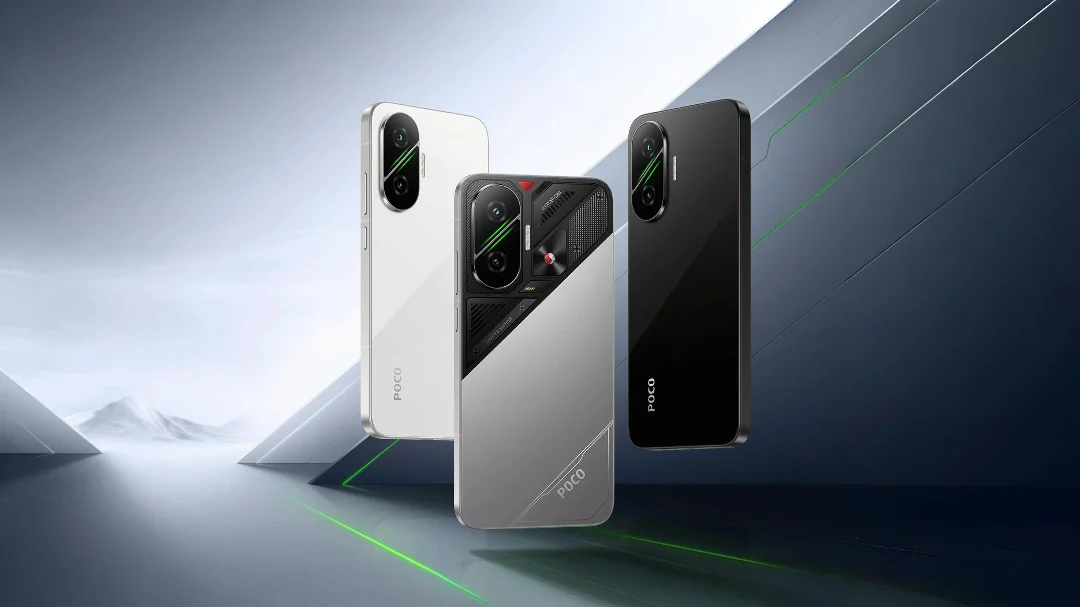The POCO F7 is the last in the series to land, but it might just be the most refined yet. While rivals like the OnePlus Nord 5 and Nothing Phone 3 have grabbed headlines, POCO chose a quieter route—delivering more power and polish where it counts, without inflating the price.
It sticks to POCO’s usual playbook: performance-first, with a flagship-grade chip at the core. But this time, you also get a sharper design, better update support, and a launch price just under ₦400,000 in most markets.
If you’ve been waiting to upgrade without overpaying, the F7 is worth a closer look. Let’s see where it stands out, and where it still trails the competition.
Key Specs
- Display: 6.83″ AMOLED, 120 Hz refresh, peak 3,200 nits brightness
- Processor: Snapdragon 8s Gen 4
- Storage: 12 GB RAM + 256 GB or 512 GB
- Operating System: Android 15 with HyperOS 2
- Design & Proof: Glass front/back, aluminum frame, IP68, Gorilla Glass 7i, Dolby Vision, HDR10+, TÜV Rheinland low blue light
- Cameras: Rear: 50 MP Sony IMX882 + 8 MP ultrawide + 20 MP selfie; Video recording: Up to 4K @ 60fps (rear), 1080p @ 60fps (front)
- Battery & Charging: 6,500mAh, 90W + 22.5 W reverse charging
- Weight: 215.7g
- Other: Under-display fingerprint sensor, stereo speakers, NFC, infrared blaster, USB‑C, Wi‑Fi 7, Bluetooth 6.0
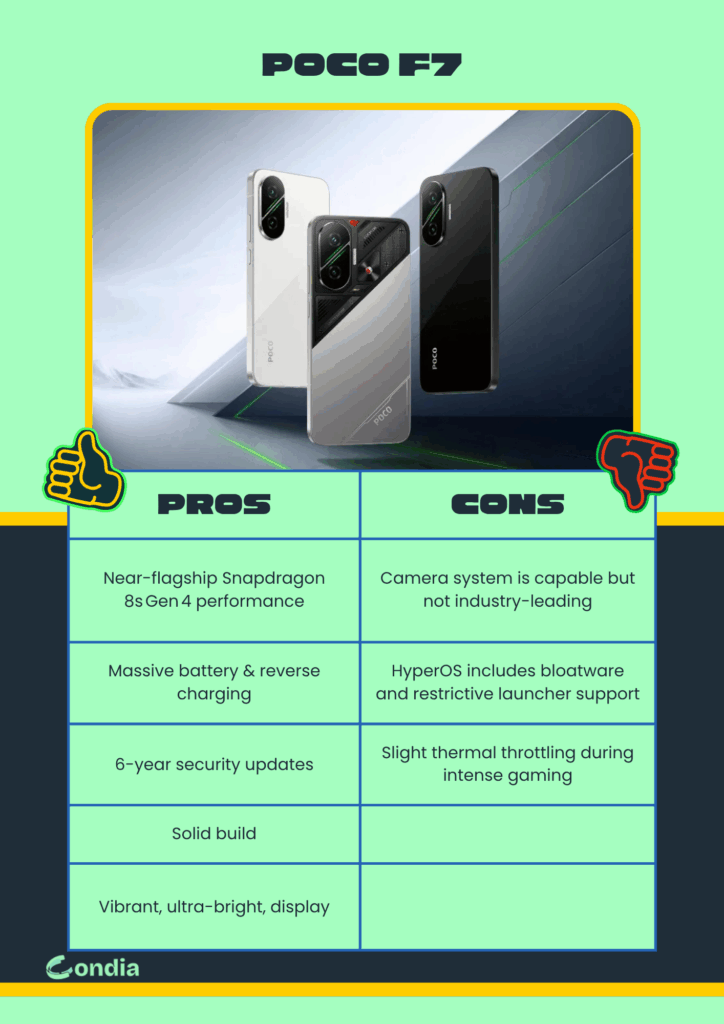
How special is the design and build quality of Poco F7?
The POCO F7 doesn’t play it safe. It actually feels and looks more premium than what you’d expect at this price point. The back is made of glass, giving it a glossy finish that feels nice to the touch. It does pick up fingerprints, especially on the darker colors, but that’s expected. If you’re into bolder styles, the Cyber Silver variant makes a statement with faux circuit elements, printed screws, and a Snapdragon logo across the back. Prefer something calmer? The black and white versions keep things minimal.
Despite weighing 215.7g, it doesn’t feel clunky. The aluminum alloy frame adds to the build quality, and the 8.2mm thickness with flat edges makes it easier to hold. The bezels are slim, and it carries an IP68 rating for dust and water resistance—still rare at this price. Bonus: the touchscreen works even when wet, thanks to Xiaomi’s “Wet Hand Touch 2.0” feature.
You also get useful extras right in the box: a pre-applied screen protector, a decent silicone case, and a 90W fast charger with a USB-C cable. Just note that the USB port is USB 2.0, so while charging is fast, file transfers and video-out are limited.
In short: great feel, durable, stylish—and well-kitted from the start.
Does Poco F7 come with dual speakers?
Yes, the POCO F7 has a stereo speaker setup with Dolby Atmos support. They’re loud enough for watching Netflix, YouTube, or listening to music without needing external speakers. Compared to the Galaxy A36, they’re just a touch quieter but still deliver solid clarity.
However, when you crank the volume all the way up, the high frequencies can get a bit harsh, so it’s best to stay just below max for a smoother experience. It’s not flagship-level audio, but for a midrange phone, it more than holds its own.
There’s no 3.5mm headphone jack, so you’ll need to use Bluetooth or a USB-C adapter if you prefer wired headphones.
How’s the haptic feedback?
It’s tight and fairly precise—good enough for typing and everyday use. There’s even a setting to adjust the intensity, but even at max, it feels a bit soft. You’ll notice the vibrations, but they don’t have that deep, satisfying thump that premium flagships offer.
What unlocking methods can you use on Poco F7?
You’ve got two main options: an under-display fingerprint scanner and face unlock. The fingerprint reader is fast and works reliably most of the time, but it’s placed slightly lower than ideal, so you may need to adjust your thumb position at first.
Face unlock is snappy too and works well in good lighting. But keep in mind, it uses the front camera alone, so it’s less secure than 3D-based systems like Apple’s Face ID. It’s fine for convenience, but for things like banking apps, you’ll want to stick with the fingerprint option.
What is the display quality of Poco F7?
In one word? Stunning.
The POCO F7 features a 6.83-inch OLED display with a 1.5K resolution (1280 x 2772), 120Hz refresh rate, and HDR support. The bezels are slim, giving it a 94.2% screen-to-body ratio. It’s protected by Gorilla Glass 7i.
Brightness is a major highlight. Poco claims 3200 nits peak, and in testing, it hit 3291 nits at 20% APL. Outdoor visibility is excellent, and the screen holds up well in sunlight.
Colour accuracy is strong, with an average DeltaE of 1.64. Blacks are deep, and contrast is high thanks to the OLED panel. Minimum brightness is also good at 1.9 nits, which helps in low-light use.
The refresh rate isn’t LTPO, so you’re limited to manually switching between 60Hz and 120Hz or letting the system choose between them.
Overall, this is one of the best displays you’ll find in the upper midrange—flagship-tier brightness, accurate colors, and immersive visuals, all protected by Gorilla Glass 7i.
What is special about the processor and performance of the phone?
The POCO F7 is powered by Qualcomm’s Snapdragon 8s Gen 4, and on paper, it’s a major leap for the series. This chip lands just below the Snapdragon 8 Gen 3 and surprisingly closes the gap in GPU-heavy tasks, even edging past the Galaxy S25 Ultra in certain 3DMark scores like Steel Nomad Light and Solar Bay.
It’s paired with 12GB of RAM and UFS 4.1 storage as standard, which helps app launches and multitasking feel smooth and snappy. While there’s no microSD slot, the 256GB and 512GB variants offer plenty of room for most users.
In benchmark tests, the F7 scores roughly 50% higher in multi-core and 80% higher in GPU performance than the Pixel 9a. Compared to the Xiaomi 15, it’s about 30% slower in graphics, which tracks given the 15 uses the top-tier Snapdragon 8 Elite. Still, the F7 holds its own surprisingly well in this tier.
But there’s a trade-off, heat. Under sustained load, the phone has been shown to throttle aggressively. In one 3DMark Wild Life Extreme stress test, MyNextTablet reported that it shut down entirely due to high temperatures. In actual gameplay, frame rates in Call of Duty: Warzone Mobile start high but quickly drop from 90 to around 40 FPS after 15 minutes of play. Lighter games might show better stability but still generate noticeable heat.
Dialing down graphics settings or frame caps can help maintain performance. And while Xiaomi’s “Overclocked” Game Boost mode promises more power, it often leads to more heat without much gain, making it better left off.
Overall, the Snapdragon 8s Gen 4 delivers flagship-adjacent performance, especially in short bursts or day-to-day tasks. Just don’t expect to marathon your favorite AAA mobile title at max settings without things getting warm. For gamers, this might be a “keep a fan nearby” kind of phone.
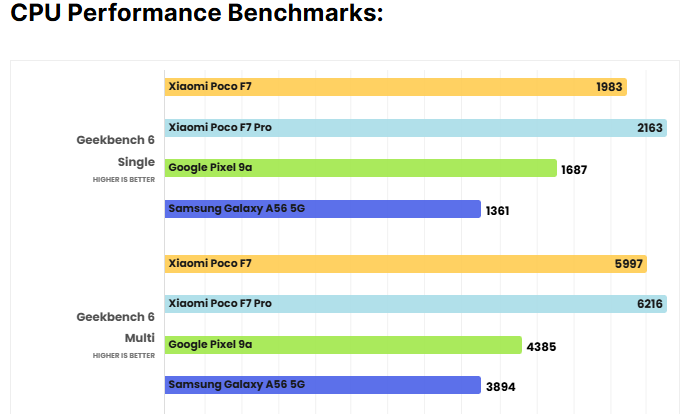
(Benchmark scores show the Snapdragon 8s Gen 4 landing close to the Snapdragon 8 Gen 3, used in the POCO F7 Pro, with Gen 3 still holding a slight 5% edge in performance.)
How is the camera setup and does it really have an ultrawide lens?
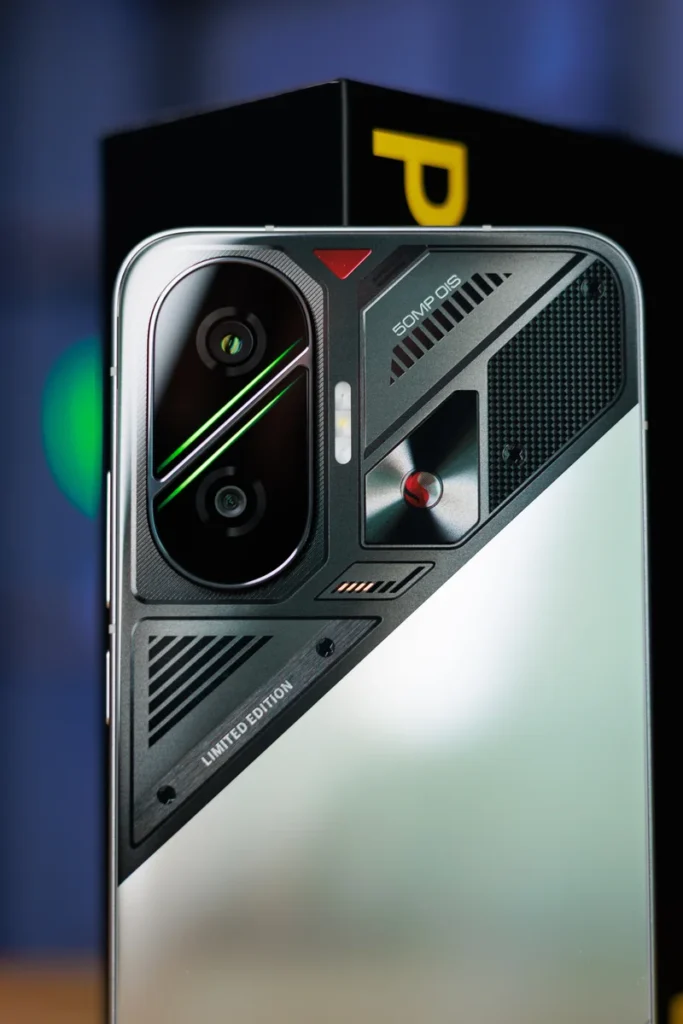
Yes, the POCO F7 has a dual camera setup on the back, a 50MP Sony IMX882 main sensor with OIS and a smaller 8MP ultrawide lens. The main camera shoots 12MP images by default via pixel binning and can record 4K at 60fps. In good lighting, images come out sharp and detailed, with neutral color processing. It doesn’t overdo skin tones like the Galaxy A36, which we compared it to. RAW shooting is supported too, though noise creeps in under low light.
The ultrawide is decent for casual use but noticeably softer and less vibrant than the main camera. It still edges out the A36’s 8MP ultrawide when it comes to video clarity and color consistency, even though both use similar hardware.
For selfies, there’s a 20MP front camera that delivers sharp portraits with solid edge detection. However, it tops out at 1080p video, a step behind rivals like the Galaxy A36 that offer 4K front-facing video.
How is the battery and charging performance of Poco F7?
Battery life is one of the POCO F7’s standout features. It packs a big 6,500mAh silicon-carbon battery, and under regular use—browsing, light gaming, and video streaming—it comfortably stretches across two full days, sometimes pushing three.
In a full-brightness YouTube playback test, it lasted a record 29 hours, outperforming the Pixel 9a, Xiaomi 15, and even the Galaxy S25 Ultra by several hours.
Charging is just as fast as its battery is big. With 90W wired charging, you can hit 90% in about 30 minutes and full charge in roughly 40 minutes. But take note: fast charging is off by default and has to be manually enabled in the settings. Also, expect some warmth while charging—nothing alarming, but it’s there.
There’s no wireless charging support, which is expected at this price, but still worth pointing out. Overall, for endurance and recharge speed, the F7 delivers on its promises. Optimisation with the Snapdragon 8s Gen 4 might need some tuning, but the battery performance still puts it ahead of most rivals.
How is the software and UI of Poco F7?
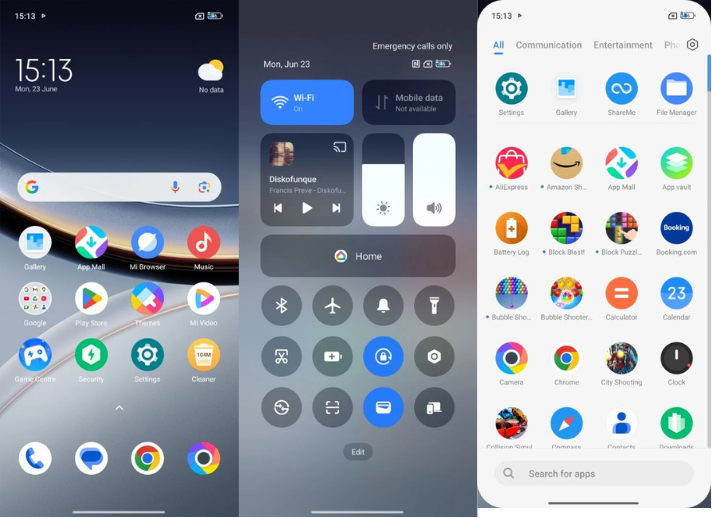
The POCO F7 runs on HyperOS 2 based on Android 15, and Xiaomi has confirmed four major Android updates and six years of security patches, thanks in part to new EU regulations. That means you’re covered until 2030 for basic security, which is solid for a phone at the 400,000 price bracket.
HyperOS feels fast, customisable, and fluid. You can tweak layouts, switch between an app drawer or home screen-only setup, and apply dynamic wallpapers. It’s a much smoother experience than MIUI, with better memory management and UI polish. But not everything is rosy.
There’s still a lot of pre-installed bloatware, including apps like Temu, LinkedIn, and some games, and you don’t get the option to skip them during setup. Ads and recommendations also show up in areas like the wallpaper store or security app, which cheapens the experience a bit. While most of this can be turned off or uninstalled, it’s still something to be aware of.
On the plus side, AI tools are well integrated. You get Google Gemini out of the box (mapped to the power button by default), Circle to Search, and Xiaomi’s own AI Interpreter, AI Gallery Editor, and voice-based tools. They work well, though many features require an internet connection to function fully.
What is the price and availability of Galaxy Poco F7?
The POCO F7 starts globally at $260, which roughly converts to ₦400,000 in Nigeria, depending on the exchange rate. It comes in two variants: 12GB + 256GB and 12GB + 512GB and is available in Black, White, and Cyber Silver.
If you’re considering the Pro model, that version features the more powerful Snapdragon 8 Gen 3 and starts around ₦443,000 when converted from its base pricing.
Here’s how pricing looks in different markets:
| Country | Variants | Price Range | Retail Channel |
|---|---|---|---|
| United Kingdom | 12GB + 256GB / 512GB | £329 / £359 | Online retailers |
| United States | 12GB + 256GB / 512GB | ~$366 (₦611,500) | Redirects to AliExpress (global store) |
| Singapore | 12GB + 256GB / 512GB | S$499–S$579 (Early Bird: S$439–S$519) | Xiaomi SG, Shopee, Lazada |
| Philippines | 12GB + 256GB / 512GB | ₱17,499–₱19,499 (with vouchers) | Shopee exclusive |
| Kenya | 12GB + 256GB / 512GB | KES50,940 | Xiaomi Kenya online store & partners |
| Bangladesh | 12GB + 256GB / 512GB | BDT44,406 | Mi Store Bangladesh |
| Ghana | 12GB + 256GB / 512GB | GHS4,299 | Xiaomi Ghana online channels |
Early bird promotions kicked off on 24 June 2025 and run through 9 July 2025 on mi.com and Xiaomi partner stores in select regions. You can also get up to $30 in voucher discounts while stock lasts.
Who should buy the new Poco F7 phone?
If you want a speed-focused phone under ₦450,000 that doesn’t lag when multitasking, can game decently, and charges from 0–100% in under 20 minutes, this one is for you.
It’s ideal for:
- Techies or students who want flagship-grade performance on a budget
- Gamers who play casually and want fast refresh rates and high brightness
- Anyone switching from a budget phone and wants a faster, future-proof upgrade
Skip it if camera quality or polished software are your top priorities. This isn’t a content creator’s phone, but it’s fast, capable, and priced right.
Our Verdict: A few corners were cut, but the essentials were not
The POCO F7 gets a lot right for its ₦400,000 starting price. It’s powered by the Snapdragon 8s Gen 4, backed by 12GB RAM, UFS 4.1 storage, and a vivid 6.83-inch AMOLED display with 120Hz refresh rate and 1800 nits peak brightness. Add 120W wired charging, decent stereo speakers, and four years of OS updates, and you’ve got a device that covers the essentials for power users and casual gamers alike.
However, trade-offs exist. It heats up under load, limiting its full performance potential. The ultrawide camera is forgettable, and video quality caps at 4K/30fps with no 4K on the selfie cam. HyperOS is fluid but still ships with ads and bloatware, which cheapens the experience. There’s also no wireless charging or official IP rating, which some rivals offer at this price.
Still, if raw performance, fast charging, and a flagship-grade screen matter most, and you can live with average cameras, the Poco F7 remains a smart buy in the upper midrange space.
Editor’s Rating: 7/10
Get passive updates on African tech & startups
View and choose the stories to interact with on our WhatsApp Channel
Explore
